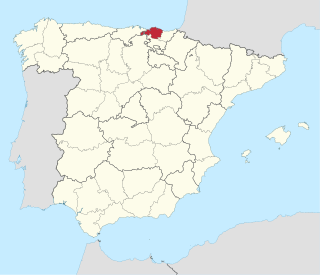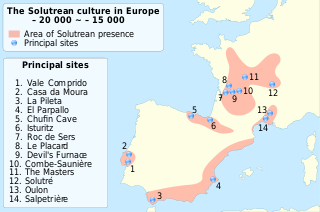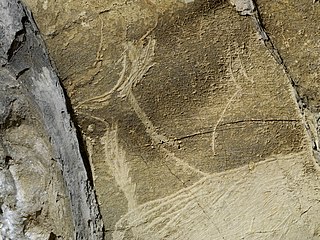
Biscay is a province of Spain and a historical territory of the Basque Country, heir of the ancient Lordship of Biscay, lying on the south shore of the eponymous bay. The capital and largest city is Bilbao.

The Cave of Altamira is a cave complex, located near the historic town of Santillana del Mar in Cantabria, Spain. It is renowned for prehistoric parietal cave art featuring charcoal drawings and polychrome paintings of contemporary local fauna and human hands. The earliest paintings were applied during the Upper Paleolithic, around 36,000 years ago. The site was discovered in 1868 by Modesto Cubillas and subsequently studied by Marcelino Sanz de Sautuola.

The Solutrean industry is a relatively advanced flint tool-making style of the Upper Paleolithic of the Final Gravettian, from around 22,000 to 17,000 BP. Solutrean sites have been found in modern-day France, Spain and Portugal.

The Magdalenian cultures are later cultures of the Upper Paleolithic and Mesolithic in western Europe. They date from around 17,000 to 12,000 years ago. It is named after the type site of La Madeleine, a rock shelter located in the Vézère valley, commune of Tursac, in France's Dordogne department.

The Azilian is a Mesolithic industry of the Franco-Cantabrian region of northern Spain and Southern France. It dates approximately 10,000–12,500 years ago. Diagnostic artifacts from the culture include projectile points, crude flat bone harpoons and pebbles with abstract decoration. The latter were first found in the River Arize at the type-site for the culture, the Grotte du Mas d'Azil at Le Mas-d'Azil in the French Pyrenees. These are the main type of Azilian art, showing a great reduction in scale and complexity from the Magdalenian Art of the Upper Palaeolithic.

Prehistoric France is the period in the human occupation of the geographical area covered by present-day France which extended through prehistory and ended in the Iron Age with the Celtic "La Tène culture".

Santimamiñe cave, Kortezubi, Biscay, Basque Country, Spain, is one of the most important archaeological sites of the Basque Country, including a nearly complete sequence from the Middle Paleolithic to the Iron Age.

The Solutrean hypothesis on the peopling of the Americas claims that the earliest human migration to the Americas took place from European Solutreans walking along pack ice in the Atlantic Ocean. This hypothesis contrasts the mainstream academic narrative that the Americas were first populated by people traveling through geographical regions such as walking along the Bering Strait and sailing across the Pacific Ocean.

The prehistory of the Iberian Peninsula begins with the arrival of the first hominins 1.2 million years ago and ends with the Punic Wars, when the territory enters the domains of written history. In this long period, some of its most significant landmarks were to host the last stand of the Neanderthal people, to develop some of the most impressive Paleolithic art, alongside Southern France, to be the seat of the earliest civilizations of Western Europe and finally to become a most desired colonial objective due to its strategic position and its many mineral riches.

Last Glacial Maximum refugia were places (refugia) in which humans and other species survived during the Last Glacial Period in the Northern Hemisphere, around 25,000 to 20,000 years ago.

Paleolithic Europe, the Lower or Old Stone Age in Europe, encompasses the era from the arrival of the first archaic humans, about 1.4 million years ago until the beginning of the Mesolithic around 10,000 years ago. This period thus covers over 99% of the total human presence on the European continent. The early arrival and disappearance of Homo erectus and Homo heidelbergensis, the appearance, complete evolution and eventual demise of Homo neanderthalensis and the immigration and successful settlement of Homo sapiens all have taken place during the European Paleolithic.

The greater Basque Country comprises the Autonomous Communities of the Basque Country and Navarre in Spain and the Northern Basque Country in France. The Prehistory of the region begins with the arrival of the first hominin settlers during the Paleolithic and lasts until the conquest and colonisation of Hispania by the Romans after the Second Punic War, who introduced comprehensive administration, writing and regular recordings.
The Asturian culture is an Epipalaeolithic or Mesolithic archaeological culture identified by a single form of artefact: the Asturian pick-axe, and found only in coastal locations of Iberia, especially in Eastern Asturias and Western Cantabria. It is believed that the Asturian tool was used for seafood gathering, and the sites where they are found are associated with very large shell-middens, which can fill caves to the ceiling.

Cave del Valle, locally also known as La Viejarrona, is located near El Cerro Village in the municipality of Rasines in Cantabria, northern Spain. The cave is the source of the Silencio River, a tributary of the Rio Ruahermosa, which in turn is a tributary of the Asón River. Notable for its prehistoric, but particularly for its speleologic significance as it is recognized as one of the longest cavities in the world. The site is very popular among cavers, who have explored a total of over 60 km (37.28 mi) so far.

The Cantabrian caves' unique location make them an ideal place to observe the settlements of early humans thousands of years ago. The magnificent art in the caves includes figures of various animals of the time such as bison, horses, goats, deer, cattle, hands and other paintings. Archaeologists have found remains of animals such as bears, the remains of arrows and other material indicating a human presence; these artifacts are now found mostly in the Regional Museum of Prehistory and Archaeology of Cantabria.

The Cave of Altamira and Paleolithic Cave Art of Northern Spain is a grouping of 18 caves of northern Spain, which together represent the apogee of Upper Paleolithic cave art in Europe between 35,000 and 11,000 years ago. In 2008, they were collectively designated a World Heritage Site by UNESCO.

The Cave of Altxerri is located in the municipality of Aya (Gipuzkoa) in the Basque Country (Spain).

The El Mirón Cave is a large cave in the upper Asón River valley towards the eastern end of Cantabria in northern Spain, near the border of the Basque Country. It is an archeological site in Ramales de la Victoria. It is known for a skeleton belonging to a woman nicknamed The Red Lady of El Mirón. She is estimated to have died around 18,700 years ago, during the Upper Paleolithic (Magdalenian). The skeleton is examined to that of someone between 35 and 40 years. Her bones were coated with ochre, a red iron-based pigment, hence, her name.

The La Garma cave complex is a parietal art-bearing paleoanthropological cave system in Cantabria, Spain. It is located just north of the village of Omoño, part of the municipality of Ribamontán al Monte. The cave complex is noted for one of the best preserved floors from the Paleolithic containing more than 4,000 fossils and more than 500 graphical units. It is part of the Cave of Altamira and Paleolithic Cave Art of Northern Spain World Heritage Site.

Vasco-Cantabria, in archaeology and the environmental sciences, is an area on the northern coast of Spain. It covers similar areas to the northern parts of the adjacent modern regions of the Basque country and Cantabria. In geology the "Vasco-Cantabrian Basin" or "Basque-Cantabrian Basin" covers the area and the seas off the coast, in the Bay of Biscay, an area between the Iberian and European tectonic plates.



















